Building and Promoting the FEL
Behind the Free Electron Laser
Meet a few of the people working on the FEL
Is your work documented?
Employee attracts world-wide attention
A Year of Continued Progression
A look at the highlights for 1996
First license signed with Dilon Technologies
RC construction update
International food festival set for February 26
Lab offers vaccination
BUILDING & PROMOTING THE FEL
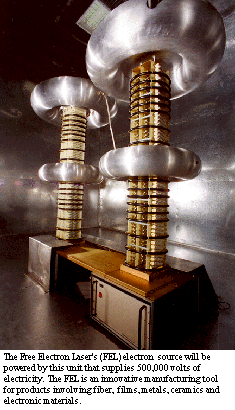 Lasers are in more demand than ever. Technological advances have allowed lasers to perform functions that were never before possible. They have also allowed for the creation of new kinds of lasers.
Lasers are in more demand than ever. Technological advances have allowed lasers to perform functions that were never before possible. They have also allowed for the creation of new kinds of lasers.
One such laser is the Free Electron Laser (FEL). Although the idea of an FEL has been around for some time, Jefferson Lab has enhanced the concept into an efficient product. The FEL works a lot like a regular laser except it is capable of eliminating energy problems.
Fifty thousand watts of electricity are required to power the initial beam. Once the beam is sent back through the cavity, only 5,000 watts are required to power the next beam. The rest of the power comes from the beam that has already been accelerated. Recycling the electron beam makes the FEL extremely energy efficient.
"A big portion of the FEL task is recirculation," said George Biallas, systems manager for the beam transport system. "We are very dependent on the recirculation to create enough energy for the machine to run. Without recirculation you only get 100 watts of power as opposed to the 1000 watts you get with recirculation."
Developing the Laser
The advantages of a laser of this kind are numerous, says George Neil, Deputy Program Manager for the FEL. "As we're progressing into this project we're discovering more and more things that can be done with it [FEL]. This is really in response to a challenge that industry gave us when we first started talking to them back in 1992," said Neil. Jefferson Lab has pulled together a consortium of industries that are interested in developing the technology needed to manufacture the FEL. "The interested industries include Dupont, Lucent Technologies, IBM, Xerox, Newport News Shipbuilding, and Virginia Power, to name a few," says Neil. He adds, "Support for this project is coming from both state and local government levels." Fred Dylla, FEL Program Manager, says sufficient funding to start the first phase of the FEL project came through in June of 1996. The funding will last through fiscal year 1997, and will pay for the building of the infrared FEL and the Free Electron Laser Facility (now under construction). The funding is coming from a variety of sources, including the U.S. Navy, the Department of Energy, the Commonwealth of Virginia, and two industrial partners who will help build the laser and some of the equipment for user labs. "Close to $20 million will be spent by the end of fiscal year 1997," says Dylla. Money for the project was also appropriated in this year's U.S. Defense Bill, and potential support is being lined up by the Department of Defense and DOE for fiscal years 1998 and 1999.
In order to make the FEL cost effective, some major boundaries must be crossed. To use the laser for surface processing it must output more than 10 kilowatts of power. "That's because these manufacturers produce a lot of stuff. Dupont makes 20 billion pounds of nylon per year. It takes a lot of light to process that so you've got to make a big laser," says Neil. He adds that if the laser is used for micro-machining, one kilowatt may be enough to satisfy some of the applications for which the FEL would be used, but the laser must still be cost effective.
Another boundary that must be overcome involves the laser's injector. Robert Legg coordinates the commissioning plans for the FEL, and is currently working on the injector. Legg says the problem deals with the ceramics that hold off the high voltage on the electron gun, which is a component of the injector. When the electron gun operates, small electron currents are emitted. Without much voltage, an intense electric field pulls electrons off the body of the gun and embeds them into the ceramics. The problem is the ceramics can't handle the high voltages needed in order for the gun to operate properly (about 350,000 volts). "The ceramics are dielectric, they can't dissipate the electrons that hit it," said Legg. " So if you go to very high voltages it just breaks down." Several new ceramics are being manufactured to solve the voltage problem. A tube with a special coating is also being manufactured. This tube will suppress the electron currents that are emitted from the gun. Both items should be ready sometime this month," says Legg.
Applications
Once these boundaries are conquered, the laser will be able to handle what seems to be an endless amount of applications. "Using short pulses of light from the laser will enhance surface processing," says Neil. In polymers a strong absorption on the surface of the material will heat and roughen the surface layer - giving the cloth a softer feel and better adhesion for dying and bonding. Neil used nylon as an example of a polymer that can be enhanced with the FEL. "The fiber looks like fishing line; it's very smooth. Try to dye a piece of fishing line, the dye doesn't stick, the colors are shiny not bold, and it's hot so it feels terrible to wear," said Neil. "However, the fabric is durable." "If this material could be made with its present durability but more comfortable, you'd have a real product," he adds. Dupont has already made a small quantity of the enhanced nylon and it is of good quality. The problem, says Neil, is that it took Dupont one hour to make one square meter because their lasers are not powerful enough. The FEL would enable them to make thousands of square yards per day. "That's enough to go into trial manufacturing and show that there is a market for a cloth like this, and what the economics of making clothes like this would be," says Neil.
In metals, a strong absorption of the pulses can melt a shallow surface layer. This will result in a smooth glassy finish that is resistant to corrosion. "Corrosion naturally attacks metal at grain boundaries," explains Neil. "If you can eliminate those grain boundaries, you get a resistance factor of 10 to 100 to resist attack by corrosives."
The laser can also alloy the surface of materials. Using this process, the laser can alloy just the surface layer, allowing all the benefits of the metal to be obtained on the outer surface. This process is considerably cheaper than conventional methods because only a small amount of the material is used.
A metal that is highly resistant to corrosives could be used for turbine blades at nuclear and steam plants. Neil states that turbine blades need replacing every five years. In order to replace the blades the entire plant must be shut down for a week to 10 days, all of which is time lost for the plant. The metal treated by the laser would have doubled the lifetime of the metal used for the current blades. "The plant is worth a lot of money to keep on line. Industry would be willing to spend a lot of money to double the life of the turbine blade," explains Neil. "Imagine if we could improve it by a factor of five or more? This is big money. The estimate is that processing alone could be worth about one billion dollars a year."
Neil explains that if the light emitted from the laser is ultra violet light, as opposed to an infrared light, it is possible to change the chemical make up of a material. With polymers, it breaks the chemical bonds and an amine group pops above the surface. This amine group has the ability to kill bacteria. "It's still bound to the plastic, it doesn't wash away," Neil says. "What it means is hospital gowns could be made that wouldn't carry germs around from one room to another. Doctors could wear them into surgery and wouldn't have to worry about carrying infections around on their rounds." Neil adds that the plastic could also be used to make a wrap for foods in grocery stores that would kill bacteria and prevent the foods from spoiling. "We need to get the UV system before we can test this because this is a chemical interaction. It has tremendous commercial prospects and Dupont is very excited about it. They could sell a lot of this if we can make it for a reasonable price," says Neil.
In addition to all of the above mentioned applications, it is believed that there are even more applications that have yet to be thought of.
"In fiscal year 1998 we will have to make the laser work. That will be a six month effort," says Court Bohn, Deputy Program Manager for the FEL. "In the middle of 1998 we will start to use the laser for the first experiments." A large group of scientists, engineers and technicians are presently putting in long hours to make this program a success, and according to Bohn, all things are going well and prospects for additional funding "look good."
"It's a great technical challenge and we're getting terrific support, dedication, and creativity from not only the core team, but the whole Accelerator Division," says Neil. "We hope to spin-off the technology and develop commercialized versions of this and, along with some of our partners, produce something that can be manufactured in industry and located on the industry's sites. Then they can take over the processing and incorporate the light output into the rest of their manufacturing as the material comes off their manufacturing line."
HOW A LASER WORKS
Electrons travel in orbits around the nucleus of an atom. If an electron becomes excited by light, it will move to an orbit that exists at a point higher and wider than the original orbit. This orbit is not the natural habitat of the electron and at some point the electron will jump back down to its original orbit. The photon that is emitted when the electron jumps down is called spontaneous emission. This will continue until all the electrons relax to their natural state.
The same thing happens when a laser is created, only on a larger scale. To create a laser there must be a lot of atoms for the light to pass through, so the emitted light can build to high levels. The photon emitted from the first excited atom causes the excited electrons in other atoms to relax immediately to their natural state and emit additional photons traveling in the same direction. This is called stimulated emission. Because this process must grow from a low level to a higher level (more than a billion times higher), scientists place slightly curved mirrors on both ends of the matter the light is traveling through. This causes the beam of light to bounce back and forth between the mirrors, thus enhancing the amount of light given off. One of the curved mirrors is 100 percent reflective, the other is 95 percent reflective. That five percent that is not reflective allows five percent of the light to leak out of the matter. The light that leaks out is the laser beam.
This fascinating process, however, has its problems. In order to create the power beam needed by industry, extreme excitation levels must be used. Only a small amount of energy is actually used; the rest of the energy is left inside the material. This causes a lot of heat and energy problems for the technicians running the laser.
The Free Electron Laser is different from a regular laser in that it uses very fast moving electrons, which if directed around a bend, will spontaneously produce light. In order to bend the electron beam repeatedly, a device called a "wiggler" is used. The "wiggler" is a succession of magnetic fields, of alternating polarity, that are spaced at an equal distance from each other. As the beam passes through the "wiggler," the electron's path is bent by the magnetic field. Because the magnets are positioned in alternate polarity, as one point on the electron beam bends down, another point bends up. This creates the wiggle or wave effect, which causes photons to be emitted. Stimulated emission is achieved, but this time the excess heat and energy exit at the speed of light.

BEHIND THE FREE ELECTRON LASER
Meet a few of the people working on the FEL
Lawrence Dillon-Townes
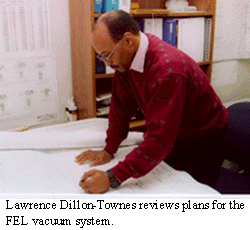 Need a new vacuum? Well Lawrence "Butch" Dillon-Townes can make one that can not only clean up dirt, but can also clean up the air. Dillon-Townes is the Mechanical Project Engineer for the Free Electron Laser (FEL), and is responsible for the entire FEL vacuum system.
Need a new vacuum? Well Lawrence "Butch" Dillon-Townes can make one that can not only clean up dirt, but can also clean up the air. Dillon-Townes is the Mechanical Project Engineer for the Free Electron Laser (FEL), and is responsible for the entire FEL vacuum system.
The molecules in the air make the FEL vacuum system necessary.
"In a vacuum, we try to take as many molecules out of the air as possible so the beam has an unimpeded path. The better the vacuum the less particles you have, because what you're doing is sucking those particles out with pumps. The more particles you suck out the less chance the beam has of impacting anything," said Dillon-Townes.
Dillon-Townes' responsibilities include supervising the design of the vacuum chambers and specifying the location and number of pumps and beam pipes for the vacuum. Dillon-Townes said that although the diagnostic equipment comes from other people, it is up to him to make sure all the components fit into the vacuum system. "It's a lot of fun because I get to interface with all the other groups to make sure the final product comes out like it should," said Dillon-Townes.
When Dillon-Townes came to Jefferson Lab in 1989 he was in charge of all the infrastructure groups at the Lab. That included the Machine Shop, Document Control, Mechanical and Electrical Drafters, Stock Room, Technical Illustration, and Fabrication Flooring. Since he has been working with the FEL group, Dillion-Townes has had the opportunity to refine some of his skills.
"I'm a mechanical engineer but I'm trying to develop my expertise in vacuum systems. Although I worked with vacuum systems when I worked at NASA, this is the most intense system I've worked on. It's definitely a learning experience," said Dillon-Townes.
Michelle Shinn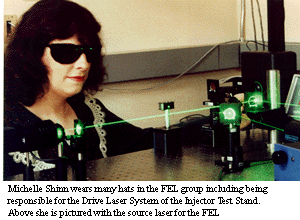 Want to learn how to build a laser? Just ask Michelle Shinn, the former Physics professor. Shinn, who came to Jefferson Lab as a Casual Employee on leave from Bryn Mawr College in Pennsylvania, is the Systems Manager for Optics for the Free Electron Laser (FEL). She is also one of the key people, along with Steve Benson and George Neil, responsible for the optics design of the FEL.
Want to learn how to build a laser? Just ask Michelle Shinn, the former Physics professor. Shinn, who came to Jefferson Lab as a Casual Employee on leave from Bryn Mawr College in Pennsylvania, is the Systems Manager for Optics for the Free Electron Laser (FEL). She is also one of the key people, along with Steve Benson and George Neil, responsible for the optics design of the FEL.
Shinn is also responsible for the Drive Laser System of the Injector Test Stand. In both cases, Shinn must make sure the laser, all diagnostics, and beam delivery are completed on time and coincide with performance specifications.
As part of her work on the FEL, Shinn is accountable for the proper design and manufacture of the two mirrors which reflect the photon beam as it goes through the wiggler. "When the beam hits the mirrors there isn't perfect reflection; there's a little bit of absorption so the mirrors warp a little bit. So we have to calculate the effects of the distortion on the beam and how we should compensate for that distortion," said Shinn.
Shinn, along with student interns working on the FEL, has been working on several diagnostic devises that will be used when delivering the beam to the user labs. "If the FEL moves even 20 nanometers (20 billionths of a meter) we can measure it, and we can tell if it got longer or shorter," said Shinn.
Dave Engwall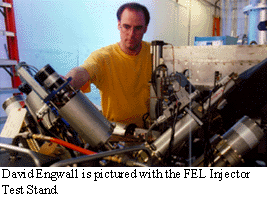 "If the Injector Test Stand doesn't work well, the FEL doesn't work well. "That's how David Engwall, a graduate student from the University of Illinois, describes the importance of the FEL Injector Test Stand.
"If the Injector Test Stand doesn't work well, the FEL doesn't work well. "That's how David Engwall, a graduate student from the University of Illinois, describes the importance of the FEL Injector Test Stand.
Engwall came to Jefferson Lab in December of 1992 to work on the Injector Test Stand as his thesis project. There are three phases of the Test Stand. The first phase studies the transverse emittance (or measurement of the beam as it comes out of the electron gun). The second phase examines the longitudinal emittance of the beam, and the third phase involves running experiments with the electron gun.
The transverse emittance is a measurement of beam quality. Roughly speaking, says Engwall, the emittance is the product of a beam's size and divergence so that for a given beam diameter, the smaller the beam's emittance, the smaller the beam's divergence. The goal of the FEL team is to achieve a beam emittance that allows the FEL to operate efficiently. "The smaller the emission the better the FEL will work. The larger it is, the worse the FEL will work," says Engwall.
Engwall adds that there are not many effective ways of reducing the emission once it gets too big to run with the FEL. That is why there is a constant concern that the emittance never gets too big. "We use computer codes to simulate what the electron beam is doing, so we can be as certain as possible that the FEL will work," says Engwall.
Now that the experimental portion of Engwall's thesis is done, he is now working on the second phase - analyzing the data. "I must now make sure one of those codes works properly by comparing the emittances I have measured with the emittances the computer has predicted," he says.
FOR THE RECORD
Is your work documented?
There is an interesting history behind the development of Jefferson Lab. In 1983, the Nuclear Science Advisory Committee of the Department of Energy recommended the construction of a nuclear physics laboratory in Newport News, Virginia. This exciting history is chronicled in various reports kept in the archives. These "records", like many other types of records, contain valuable scientific and technical information on technologies, innovations, research, people and events which have shaped Jefferson Lab. The scientific and technological breakthroughs accomplished at the lab are unprecedented anywhere in the world and should be accurately documented.
Every individual at Jefferson Lab creates records during the course of the day. Records are any recorded information on paper, videotape, floppy disk, and photographs. Records are typically categorized as temporary (having a predetermined disposition date), permanent, historical or archival, and vital (critical to the lab's continued operation). The Records Management Office (RMO) provides assistance in establishing systematic control and maintenance of laboratory records. Records coordinators from various offices throughout the site act as liaisons with the RMO. These people are the first point of contact in developing storage, transfer, preservation, or disposition of records.
The RMO encourages everyone to maintain accurate and up-to-date records in order to preserve the groundbreaking work being done at Jefferson Lab. The records program ensures that Jefferson Lab operates according to best business practices in managing its valuable records. It can provide optimum legal and regulatory protection by adhering to established guidelines. To find out more about employee records responsibility, contact the RMO at X-7525. Watch for the forthcoming Web page that is currently under construction.
BODYBUILDING NATURALLY
Employee attracts world-wide attention
In Jefferson Lab's world of high-tech research, house-sized equipment, and nuclear particles, works David Hamlette - a 28-year-old father of two, radiological technologist and 1993's Mr. Atlantic Coast. This Jefferson Lab employee holds four body building titles, and recently placed fourth in the World Natural Bodybuilding Federation's World Championships.
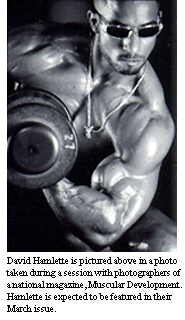 The victory drew the attention of the editor of a popular fitness magazine, Muscular Development, landing Hamlette a day-long photo shoot. The editor, who is interested in promoting the natural side of the bodybuilding sport, chose Hamlette out of the hundreds of competitors. The photos will appear in an upcoming issue.
The victory drew the attention of the editor of a popular fitness magazine, Muscular Development, landing Hamlette a day-long photo shoot. The editor, who is interested in promoting the natural side of the bodybuilding sport, chose Hamlette out of the hundreds of competitors. The photos will appear in an upcoming issue.
Posing and flexing on demand, Hamlette experienced a taste of what could become a full-time career.
However, he keeps his future plans firmly planted. "In five years I want to own a gym for personal training. In 10 years, I hope to still be competing," says Hamlette "I will train until I can't do it anymore."
Meanwhile, don't look for Hamlette to be star struck. He remains low-key and takes all of the attention in stride. Hamlette, who has a bachelor's of science degree in Technology from North Carolina A&T University, continues his work at Jefferson Lab where he is in charge of calibrating radiological instruments and providing radiological support. His work includes surveying the accelerator and experimental halls, maintaining contamination controls, and writing procedures to keep the laboratory in compliance with federal regulatory requirements.
There are no magic potions that can take credit for Hamlette's chiseled physique. He maintains that his success comes from eating healthy foods, getting plenty of rest, and exercising regularly. "It is not just a way of life for me anymore, my body is attune to it; any deviations will make me sick or fatigued," he says. "When you work hard, you enjoy seeing the results." Hamlette stays away from fried foods, sweets, ketchup and large amounts of sodium. He eats a lot of chicken and fish and drinks at least a gallon of water each day.
His workout is just as regimented. Hamlette spends 21 hours a week in the gym preparing for a competition. Each body part receives equal attention. With the average competitor weighing 215 to 220-pounds, Hamlette's symmetrical 185-pound frame creates the illusion of having more weight. "My symmetry is probably one of the things that will catapult me to the top ranks," he says.
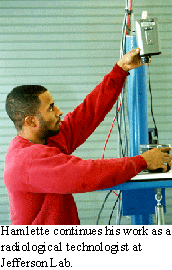 Over the past 8 years, Hamlette educated himself on bodybuilding, weight training and nutrition. He shares his knowledge with clients who hire him as their personal trainer. His business, N-Shape Professional Training, is responsible for launching two trainees into top bodybuilding competitors. In a recent competition held in Hampton, Katie Cartwright placed first in the Short Class, while Pamela Banks placed first in the Novice, Master's and Tall classes. Banks later won overall in the Novice and Master's events. Hamlette's trainees then competed against each other in the Open Overall category. Banks won, taking home six trophies in only her second competition. "Myself and others believe that Pam has the potential to be a national champion," Hamlette says.
Over the past 8 years, Hamlette educated himself on bodybuilding, weight training and nutrition. He shares his knowledge with clients who hire him as their personal trainer. His business, N-Shape Professional Training, is responsible for launching two trainees into top bodybuilding competitors. In a recent competition held in Hampton, Katie Cartwright placed first in the Short Class, while Pamela Banks placed first in the Novice, Master's and Tall classes. Banks later won overall in the Novice and Master's events. Hamlette's trainees then competed against each other in the Open Overall category. Banks won, taking home six trophies in only her second competition. "Myself and others believe that Pam has the potential to be a national champion," Hamlette says.
Not all of his clients compete, however. Each client has their own diet and workout routine to meet different goals, from competing to losing weight to gaining strength. "I tailor each program to the individual," he says. The challenges have come steadily and in varied packages since Hamlette's first show in 1988 when he won Mr. Greensboro. But the feedback from the crowd, keeps him motivated. "There's nothing like that feeling," he claims. Perhaps his biggest challenge is maintaining a balance between competition and quality family time.
"Communication is the key," says Hamlette, who adds that his biggest supporter is his wife, Illa, a staff administrator at New Horizons Technical Center in Kiln Creek. "I realize that after working out, I can't just come home and watch the football game." Hamlette says he does his share of "running things" around the house, including the dishwasher and vacuum cleaner. Evenings are also spent playing with his two daughters, Jasmin, 9, and Imoni, 2.
"The gym is important, but not as important as they are," says Hamlette.
Titles Earned |
||
| 1988 | Mr. Greensboro | Overall |
| 1988 | Mr. Mountaineer | Runner-Up |
| 1989 | Mr. North Carolina | Runner-Up |
| 1990 | Mr. Virginia Grand Prix | Overall |
| 1990 | Mr. North Carolina | Runner-Up |
| 1992 | Mr. Tri-States | Overall |
| 1993 | Mr. Atlantic Cost | Overall |
| 1993 | U.S. Chiropractic Cup (First Pro Contest) | 7th Place |
| 1995 | U.S. Championships (Second Pro contest) | 5th Place |
| 1996 | World Natural Bodybuilding Federations World Championships | 4th Place |
A YEAR OF CONTINUED PROGRESSION
A look at the highlights for 1996
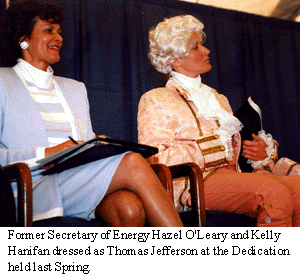 The winds of change blew through Jefferson Lab in 1996 leaving behind a new name, e-mail address and logo. And while the Lab's identity may have changed to the outside world, the mission to provide a state-of-the-art facility to the nuclear physics community remains.
The winds of change blew through Jefferson Lab in 1996 leaving behind a new name, e-mail address and logo. And while the Lab's identity may have changed to the outside world, the mission to provide a state-of-the-art facility to the nuclear physics community remains.
On May 24, 1996, then Secretary of Energy Hazel O'Leary officially dedicated the Continuous Electron Beam Accelerator Facility under its new name, the Thomas Jefferson National Accelerator Facility (Jefferson Lab). The celebration that included more than 2,000 staff members and local, state and federal politicians, marked the climax of more than 20 years of perseverance, teamwork, collaboration and cooperation among the scientific community, the Commonwealth of Virginia, the U.S. Department of Energy and the SURA institutions, to build and commission the accelerator and begin the experimental program. The event not only recognized the significant accomplishment of completing the construction phase of the facility on time and within budget, but also illustrated the important role the laboratory has grown to fill in the Southeast, as a world class center for nuclear physics and a resource for research and technological innovation.
Among those recognized for their efforts included James McCarthy for his vision in creating an accelerator, and then turning that vision into a concrete proposal. Invited speaker, Martin Perl, 1995 Nobel Laureate for Physics, challenged the physicists to make new discoveries and to not be discouraged by the hardness of nature.
There were many noteworthy accomplishments for the laboratory in 1996.
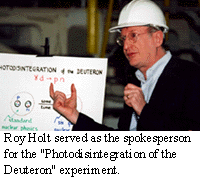 Five experiments were conducted in Hall C - the first of the three experimental halls to come on-line - bringing the total of experiments conducted to six. Among the experimenters were Roy Holt of the University Illinois who led the investigation of the deuteron, and Keith Baker and Ben Zeidman of Hampton University who probed the kaon - marking the first major experiment conducted by faculty from a Historically Black College or University at a national laboratory concentrating in Nuclear Physics.
Five experiments were conducted in Hall C - the first of the three experimental halls to come on-line - bringing the total of experiments conducted to six. Among the experimenters were Roy Holt of the University Illinois who led the investigation of the deuteron, and Keith Baker and Ben Zeidman of Hampton University who probed the kaon - marking the first major experiment conducted by faculty from a Historically Black College or University at a national laboratory concentrating in Nuclear Physics.
The accelerator had major accomplishments, as well. On April 18, 1996, the first single-pass 845 MeV beam was delivered to the Hall A target. On April 14, one-pass, 1-GeV beam was accelerated. On December 5, first beam was delivered to Hall B and 525-kilowatt beam was delivered to Hall C. December 15, polarized beam was delivered to Hall C.
Maintaining cryogenics for the accelerator, experimental halls and the FEL was a big feat for the Cryogenics Group. Their biggest effort was maintaining the refrigeration systems at 98 percent availability this year. Other major efforts for the year include modifying and rebuilding a cold box to use as the back up refrigerator for the Central Helium Liquifier (which keeps the accelerator cooled to near absolute zero); installation of a cryogenic system in the Test Lab for the Free Electron Laser's Injector Test Stand; and designing, fabricating and installing connections between the CHL and the back up refrigerator.
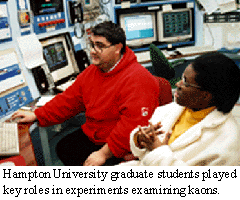 In preparation for all of the data anticipated from experiments, the Computer Center procured a new computer silo which is capable of scaling up to handle the 10 MB/per second of data anticipated to be produced by Hall B this year.
In preparation for all of the data anticipated from experiments, the Computer Center procured a new computer silo which is capable of scaling up to handle the 10 MB/per second of data anticipated to be produced by Hall B this year.
The Free Electron Laser project made many strides in 1996. A potential application of an FEL-type laser for shipboard defense has led to Congressional funding of an FEL program in the Department of the Navy for fiscal years 1996 and 1997. The Navy provided $8.1 million to Jefferson Lab through DOE that has initiated actual construction of the first phase of the laser to be housed in a new $5 million building funded by the Commonwealth of Virginia. Commissioning of the laser is expected in October 1997. (Please see related stories beginning on page 1.)
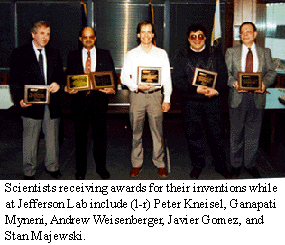 Other Technology Transfer initiatives included a Memorandum of Understanding signed January 17th with the Center for Innovative Technology to market Jefferson Lab inventions to industry. There were also several scientists awarded for inventions created while pursuing Jefferson Lab's fundamental research mission. They include Javier Gomez, Stan Majewski and Andrew Weisenberger for their invention of a Non Cross Talk Multi-Channel Photomultiplier Using Guided Electron Multipliers; Ganapati Myneni for a High Sensitivity Leak Detection Method and Apparatus; and Myneni and Peter Kneisel for the invention of a Metal Sponge for Cryosorption Pumping Applications.
Other Technology Transfer initiatives included a Memorandum of Understanding signed January 17th with the Center for Innovative Technology to market Jefferson Lab inventions to industry. There were also several scientists awarded for inventions created while pursuing Jefferson Lab's fundamental research mission. They include Javier Gomez, Stan Majewski and Andrew Weisenberger for their invention of a Non Cross Talk Multi-Channel Photomultiplier Using Guided Electron Multipliers; Ganapati Myneni for a High Sensitivity Leak Detection Method and Apparatus; and Myneni and Peter Kneisel for the invention of a Metal Sponge for Cryosorption Pumping Applications.
There were several visitors to the laboratory including Martha Krebs on February 23, 1996, during which she presented Director Hermann Grunder the "DOE Distinguished Associate Award" for outstanding leadership in the successful construction of CEBAF. Senator John Warner visited on April 12, 1996, and met with the Newport News NOW organization. The Lab also hosted the14th International Conference on Particles and Nuclei (PANIC) conference. More than 600 physicists from five continents, more than 23 countries and 28 states attended the seven day conference in Williamsburg beginning May 22.
A groundbreaking ceremony on May 9 for the 120,000 square foot Applied Research Center, being built by the City of Newport News, attracted many well-wishers including Mayor Joe Frank, Christopher Newport University President Paul Trible, Virginia Delegates Mary Christian and Phil Hamilton, and State Senator Harvey Maxwell.
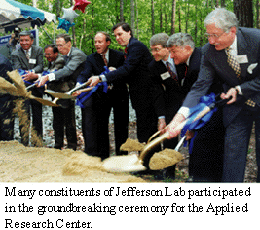 Nearly 7,000 students of all ages enjoyed the educational programs last year at the laboratory. Becoming Enthusiastic About Math and Science (BEAMS), which immerses fifth- and sixth-graders in hands-on math and science activities at the laboratory for a week, served more than a thousand students in 1996 (a total of 28,000 hours!) Eight hundred teachers participated in programs offered at the laboratory. The monthly Science Series, with topics ranging from lasers to quarks, attracted more than 2,000 participants.
Nearly 7,000 students of all ages enjoyed the educational programs last year at the laboratory. Becoming Enthusiastic About Math and Science (BEAMS), which immerses fifth- and sixth-graders in hands-on math and science activities at the laboratory for a week, served more than a thousand students in 1996 (a total of 28,000 hours!) Eight hundred teachers participated in programs offered at the laboratory. The monthly Science Series, with topics ranging from lasers to quarks, attracted more than 2,000 participants.
For the first time, boys were included in the national "Take Our Daughters to Work Day," on April 25, 1996, which attracted 82 children of employees. The visitors enjoyed a tour of the laboratory, and presentations by several staff members.
BRIEFLY...
FIRST LICENSE SIGNED WITH DILON TECHNOLOGIES
In an effort to market Jefferson Lab technologies to industry, the Technology Transfer Office has signed a license agreement and CRADA (Cooperative Research and Development Agreement) with Dilon Technologies, a Virginia company. The company will manufacture and market gamma emission technology developed by the Jefferson Lab Detector Group (see On Target, October 1996) which will be used for medical imaging for diagnostics and research purposes including detection of cancers and tumors in the breast, thyroid, brain and prostate. With the license agreement in hand, Dilon Technologies must now find venture capitalists to finance the new company.
ARC CONSTRUCTION UPDATE
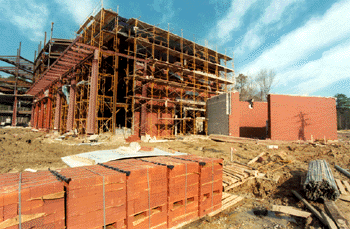
Construction of the Applied Research Center at Jefferson Lab continues on schedule with visible signs of progression. Floor slabs continue to be placed, and brick and block work are in progress. Stud walls and sheetrock are in the process of being placed, and rudimentary electrical and mechanical work have begun. Submittals for many of the interior features, such as cabinets and colors, have been approved and fabrication of these items has begun off site. Completion of the ARC is still on schedule for the fall of 1997.
Black History Month

INTERNATIONAL FOOD FESTIVAL SET FOR FEBRUARY 26
Celebrate Jefferson Lab's diversity at the annual International Food Festival on February 26, 1997, beginning at 3:15 p.m. in CEBAF Center. There will be a special performance by the Hampton University Vocal Jazz Group, directed by legendary jazz great Connie Parker, and an International Marketplace with vendors from the area. Bring your favorite dish and share your culture with Jefferson Lab staff and visitors. Join in the fun - enjoy uplifting music and food from around the world. Last year's participants enjoyed more than 40 tasty dishes including Spanish Chicken Enchiladas, Carribean Curried Chicken, Puerto Rican Pastelon and Austrian Apple Strudel. This promises to be an event you won't want to miss!
For more information, contact Deborah Hyman at X-5102 or Sabrina Bryant at X-7389.
GUARDING AGAINST PNEUMONIA
Lab Offers Vaccination
There is a group of bacteria, collectively referred to as pneumococci, that can cause serious disease. As the name suggests, they cause pneumonia, as well as meningitis and middle-ear infections. Pneumococcal diseases have high morbidity and mortality rates, and they are a leading cause of death worldwide. The disease effects appear to be the result of irreversible physiological damage caused by the bacteria during the first 5 days of the illness. This sometimes occurs despite effective antibiotic therapy.
There is another problem as well: the increasing number of bacterial strains - including pneumococci - that are resistant to antibiotics. There are lots of reasons for this predicament: injudicious and non-selective use of antibiotics, patients failing to complete their full prescribed course of antibiotic therapy, and the impressive ability of bacteria to mutate into new variants.
Ponder some statistics for the United States:
- 400,000 - 500,000 cases of pneumococcal pneumonia annually, with fatality rates of 5 to 10 percent resulting in 20,000 to 50,000 deaths per year.
- Annual incidence of pneumococcal meningitis is about 1.5 to 2.5 cases per 100,000 people. One-half of these cases are in children, and the mortality rate is about 40 percent. Even the most aggressive antibiotic therapy is often ineffective.
And these numbers are increasing. Populations at particular risk include those with certain chronic diseases (specifically those affecting the heart, lungs, liver, spleen, or kidneys), blood disorders (such as sickle-cell anemia), and those with a history of alcohol abuse. And there are other medical conditions that make pneumococcal infections especially dangerous.
There is a vaccination now available for pneumococcal bacteria - PNEUMOVAX - and it is recommended for persons 50 years of age and older or who have one of a number of risk factors. These are too numerous and detailed to be discussed adequately here.
Jefferson Lab Medical Services is offering the vaccine to lab employees. Call (269-7539) and ask for more information on risk factors and side effects, or to schedule an appointment if you are among the recommended vaccination groups.
- Those with impaired immune systems
- People with no spleen or splenic deficiencies
- Sickle-cell anemia victims and others with severe blood diseases
- Those with Hodgkin's disease, multiple myeloma, and nephrotic syndrome
HOLIDAY MEMORIES
Holiday spirit was abound at Jefferson Lab as celebrations took place in many forms.
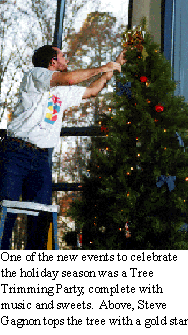 An old-fashioned tree trimming party was enjoyed on December 6 complete with baked goods, a 10 foot tree, and holiday songs performed by the Menchville High School Show Choir of Newport News.
An old-fashioned tree trimming party was enjoyed on December 6 complete with baked goods, a 10 foot tree, and holiday songs performed by the Menchville High School Show Choir of Newport News.
Santa Claus arrived on December 7 at the Eighth Annual Children's Holiday Party. Goodies and a good time were had by the 80 children who made ornaments, had their faces painted, watched holiday movies and fished in the man-made pond for prizes. The children also whispered their holiday wishes into Santa's ear, and donated enough toys to fill two boxes for Toys for Tots - a U.S. Marine Corps program that collects toys for underprivileged children.
The Williamsburg Hospitality House was the site of the annual Adult Holiday Party on December 14. One hundred eight-five people enjoyed dancing, dining and even, Bingo. Several employees donated hand-made crafts as prizes for the Bingo winners. Popular songs and dances for the evening included the Macarena and the Electric Slide; a polka was even played to the delight of Director Hermann Grunder.
On December 19, awards were handed out for door decorations. Several employees decorated their office doors for the holidays with themes ranging from a "New Year's Eve Celebration" to "Stockings Hung By the Chimney With Care." Photographs of each door were placed on the internet for employees to vote for their favorites. The students in Human Resources received first place, Steve Gagnon in Science Education won second place, and the User Liaison Office won third place.
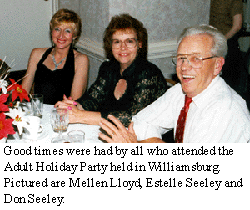 |
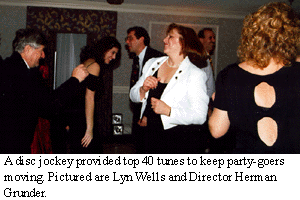 |
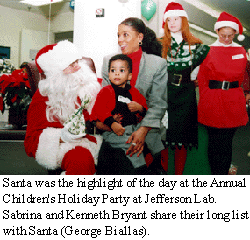 |
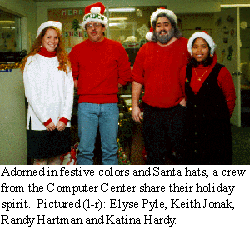 |

